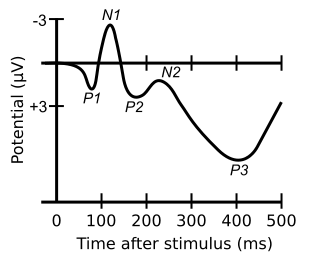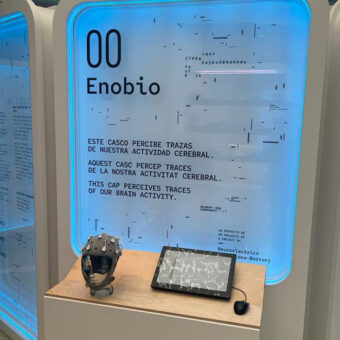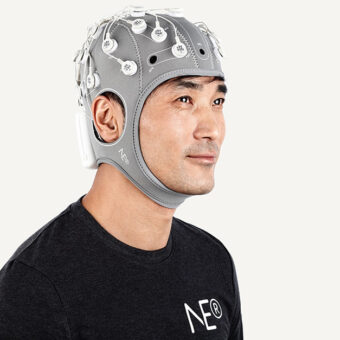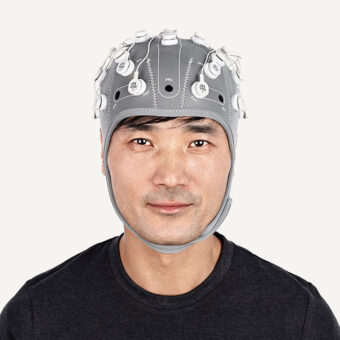To celebrate my 14th post in Neuroelectrics blog, I have decided to share 14 different ERP components and modalities with you. I presume you know a bit about ERP’s, or else please have a look at the basic ERP concepts explained in my previous post “Event-Related Potential: Our Brain Response To External Stimuli” before going through this list.
- P300: This is the most famous ERP component. It shows when using an oddball paradigm, which is when we present the subject with a series of standard stimuli and from time to time we present a deviant stimulus. This is a positive peak that shows between 200 and 700 ms after the deviant stimulus.
- Mismatch Negativity (MMN): It is somehow similar to P300 since it occurs using a similar oddball paradigm, but in this case the subject does not have to pay attention to the stimuli. It can occur in any sensory system, but it is mainly used in audition, i.e. while presenting the subject with a series of standard and deviant tones.
- Steady State Visual Evoked Potential (SSVEP): Quite widely used for BCI paradigms, this visual ERP occurs when we present the subject with flashing stimuli. If we analyse the information from the occipital electrodes, we will find the same frequency as the flashing frequency.
- Brainstem Auditory Evoked Potential (BAEP): Actually, this ERP contains several components that reflect neuronal activity in the auditory nerve, cochlear nucleus, superior olive, and inferior colliculus of the brainstem. This ERP is used to monitor the proper functioning of the auditory system for babies.
- P600: Also called Syntactic Positive Shift (SPS), it is thought to be elicited when hearing (i.e. auditory stimuli) or reading (i.e. visual stimuli) grammatical or other syntactic errors. No wonder this ERP is often used in neurolinguistical studies.
- Bereitschaftspotentia (BP): Also called Pre-Motor Potential or Readiness Potential (RP), this ERP was discovered as soon as 1964. BP is a measure of activity in the motor cortex and supplementary motor area of the brain leading up to voluntary muscle movement. It occurs between 1.2 and 0 seconds before the actual movement. It is interesting to note that some researchers have argued that we do not have free-will in the initiation of movements since the BP occurs 0.35 seconds before we are aware of our will to perform movements.
- Error-Related Negativity (ERN): It is a negative peak observed between 80 and 150 ms after an erroneous response begins. To record this ERP we have to design a task in which the subject has to make a quick decision (i.e. is this an animal?). In general, the paradigm used to elicit ERN is the so called Go/NoGo tasks. It is interesting to note that an ERN will also occur even if we are not conscious of having made a mistake.
Contingent Negative Variation (CNV): It is one of the first ERP ever to be described, as soon as 1964. The CNV is composed by a brief positive peak followed by a brief negative peak. It is elicited by presenting a single stimulus to the subject, although CNV is attenuated with time. If a second stimulus is associated with the first one, the CNV amplitude increases. These effects are strengthened when a behavioural response is required for the second stimulus. The paradigm used to elicit CNV is called chronometric paradigm. N170: First described in 1996, this ERP component reflects the neural processing of faces. It is elicited by presenting images of faces along with other type of images. N170 is generated only with the images of faces, and the increased negativity occurs between 130 and 200 ms after the stimulus is presented. Somatosensory Evoked Potentials (SEP): This ERP modality records activity in the somatosensory area of the brain and it is elicited by virtually any sensory stimuli (mechanical impacts to fingertip, air puffs, etc…). We can also record SEP’s by applying electrical stimulation on the skin over peripheral nerves, and then recording the activity in the somatosensory cortex. Several components can be found in this ERP (N25, P60, N80, P100 and N140). Early Left Anterior Negativity (ELAN): An yet another ERP component used for neurolinguistic research. ELAN appears as a negative peak around 200 ms after the stimuli onset. It most often occurs in response to linguistic stimuli (either auditory or visual) that violates a word’s category or phrase structure rules (“in the car” instead of “the in car”). In any case, it hasn’t been proven this ERP is exclusively elicited only by linguistic stimuli. Late Positive Component (LPC): This ERP has been widely used in (explicit recognition) memory studies. It has a positive peak around 400-800 ms after presenting the onset stimuli. In order to elicit LPC, the subject has to study a list of words (study phase). Then a list of words containing also new items is presented to the subject (test phase). Each time a studied word is presented, an LPC is elicited. This paradigm is called “old/new” effect. Difference Due to Memory (Dm):Dm is very closely related to the previous LPC. The idea is that if we also record ERP’s in the study phase, we can compare those to the ones elicited during the test phase. This is the so-called Difference Due to Memory. Mu-Rhythm: Although this one isn’t an ERP as such, I think it is interesting to mention it in this same list. Mu-rhythm is a 10 Hz frequency that appears in the motor cortex. When performing (or imagining) a movement, this Mu-rhythm disappears (Mu-rhythm desynchronisation). When no movement is performed (or imagined), then our Mu-rhythm appears again (Mu-rhythm synchronisation). Motor cortex BCI are based on this phenomenon.

As we have seen, ERP’s are a very powerful tool for neuroscience and cognitive research and have applications in studies of memory, linguistics, attention, motor coordination, BCI and more. I would say it is one of the most interesting applications of EEG. In any case, and opinions aside, I hope you enjoyed reading. As usual, any comments are more than welcome. See you next time!





Thankyouuuuu so much for this informative article.
Being just a new explorer into this field of cognitive neuroscience, it really amazed me how our ERPs and EEGs can show what are we about to do seconds before we actually do it. Like dude thats some amazing stuff here! And thankyou for making it even more clear for me.
Thankyou so much for sharing something like this. Keep up the greaaaat work!